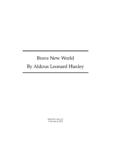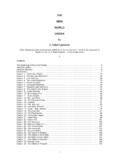Transcription of Age Standardization of Rates: A new WHO Standard
1 1 AGE Standardization OF RATES: A NEW WHO Standard Omar B. Ahmad Cynthia Boschi-Pinto Alan D. Lopez Christopher JL Murray Rafael Lozano Mie Inoue GPE Discussion Paper Series: EIP/GPE/EBD world Health Organization 2001 2 Summary A recent WHO analysis has revealed the need for a new world Standard population (see attached table). This has become particularly pertinent given the rapid and continued declines in age-specific mortality rates among the oldest old, and the increasing availability of epidemiological data for higher age groups. There is clearly no conceptual justification for choosing one Standard over another, hence the choice is arbitrary. However, choosing a Standard population with higher proportions in the younger age groups tends to weight events at these ages disproportionately.
2 Similarly, choosing an older Standard does the opposite. Hence, rather than selecting a Standard to match the current age-structure of some population(s), the WHO adopted a Standard based on the average age-structure of those populations to be compared (the world ) over the likely period of time that a new Standard will be used (some 25-30 years), using the latest UN assessment for 1998 (UN Population Division, 1998). From these estimates, an average world population age-structure was constructed for the period 2000-2025. The use of an average world population, as well as a time series of observations, removes the effects of historical events such as wars and famine on population age composition. The terminal age group in the new WHO Standard population has been extended out to 100 years and over, rather than the 85 and over as is the current practice.
3 The WHO world Standard population has fewer children and notably more adults aged 70 and above than the world Standard . It is also notably younger than the European Standard . It is important to note, however, that the age standardized death rates based on the new Standard are not comparable to previous estimates that are based on some earlier Standard (s). However, to facilitate comparative analyses, WHO will disseminate trend analyses of the complete historical mortality data using on the new WHO world Standard Population in future editions of the world Health Statistics Annual. 3 Introduction In epidemiology and demography, most rates, such as incidence, prevalence, mortality, are strongly age-dependent, with risks rising ( chronic diseases) or declining ( measles) with age.
4 In part this is biological ( immunity acquisition), and in part it reflects the hazards of cumulative exposure, as is the case for many forms of cancer. For many purposes, age-specific comparisons may be the most useful. However, comparisons of crude age-specific rates over time and between populations may be very misleading if the underlying age composition differs in the populations being compared. Hence, for a variety of purposes, a single age-independent index, representing a set of age-specific rates, may be more appropriate. This is achieved by a process of age Standardization or age adjustment. There are several techniques for adjusting age-specific rates. Among them are direct and indirect Standardization (Wolfenden, 1923), the geometric mean (Schoen, 1970), equivalent average death rates (Hill, 1977), life table rates, Yerushalmy s index (Yerushalmy, 1951), cumulative death rates (Breslow and Day, 1981), absolute probabilities of death and the comparative mortality index ((Peto et al, 1994, Breslow & Day, 1980, 1981; 1987; Esteve et al, 1994).)
5 However, with the increasing availability of age-specific rates, the use of direct age Standardization has become the predominant technique in most applications of demography and epidemiology. Direct Standardization yields a standardized or age-adjusted death rate, which is a weighted average of the age-specific rates, for each of the populations to be compared. The weights applied represent the relative age distribution of the arbitrary external population (the Standard ). This provides, for each population, a single summary rate that reflects the number of events that would have been expected if the populations being compared had had identical age distribution. Symbolically, the directly standardized mortality rate for populations A and B are given by the following equations: where nis is the mid-year population in the ith age group of the Standard population, ria and rib are the death rates in age group i in populations A and B, respectively.
6 The ratio of two such standardized rates is referred to as the Comparative Mortality Ratio (CMR), a very useful measure. If the age-specific rates in the populations being compared have a roughly consistent relationship from one age group to the next, the selection of a Standard population will not substantially affect comparisons among groups or time periods. In reality, however, the relative differences are usually not constant from one age group to another. As such, both the comparison as well as the conclusions drawn are influenced by the chosen Standard . )()( ==iisisibbiisisiaannrDSRnnrDSR 4In this paper, we review the existing Standard populations currently in use for international comparison, the Segi ( world ) and the Scandinavian ( European ) Standard populations.
7 Based on this review, a new WHO world Standard age-structure is presented for epidemiological comparisons using the direct approach. The age composition of the new Standard has been chosen to better reflect the future age structure of the world s population for which comparative rates will be needed. History of Direct Standardization By the middle of the nineteenth century, public health practitioners in England had began to recognize that simple crude rates were inappropriate summary measures for comparing population health when the age distribution of the geographic areas were markedly different. Discussions centered around the development of a summary mortality index free from the effect of age differences. In a paper he read to the Statistical Society of London, Sir Edwin Chadwick, one of the early public health reformers in England, proposed the use of the mean age at death as a summary measure for comparing the health condition of the various sanitary districts around London (Finer, 1952; Lewis, 1991).
8 This index, he argued, represented a true summary of the age-specific risks of dying. In response, Neison, a practicing actuary, disagreed with Chadwick s underlying logic. He argued that since mortality increased with age, Chadwick s mean age at death for geographic areas with a relatively older population would tend to overstate excess mortality. In a subsequent article, Neison demonstrated the fallacy in Chadwick s argument by comparing the crude mean age at death with the mean age computed by a method of direct Standardization (Neison 1844). Neison was, thus, the first to introduced both the concepts of direct and indirect Standardization , as well as the term Standard population. The Registrar General s report of 1883 was the first reported use of Neison s direct Standardization method, using the 1881 population census of England and Wales as the Standard (most current at the time).
9 In subsequent reports, the Standard was changed each time there was a new census, , every ten years (Woolsey, et al., 1959; Benjamin, et al., 1980). These frequent changes of the Standard were cumbersome since historical rates had to be recalculated each time in order to assess current trends. As a solution, the 1901 population census was eventually adopted as a general Standard in England and Wales, and remained unchanged even when a new census became available. In order to facilitate comparison with mortality rates in England and Wales, the United States adopted the 1901 British Standard . This practice continued until the early 1940s when it was decided that the difference between the US population at the time and the 1901 English population was significant enough to warrant a change in Standard .
10 As a result, the US adopted its 1940 census population (the most current at the time) as the new Standard . Recently, however, there has been growing concern that the 1940 Standard no longer reflects the increasingly older US age structure. In response, the National Center for Health Statistics sponsored two national workshops in 1991 and 1997 on the issue of a new US Standard . The final report of these workshops recommended the adoption of a new Standard based on the projected 2000 population age distribution (NCHS, 1998). 5An International Standard Population The idea of a truly international Standard was first suggested by Ogle in 1892. His proposed Standard was an amalgam based on the experience of seven European countries (Ogle, 1892).

















